- Regulatory Status
- RUO
- Other Names
- Coagulation factor III, Tissue factor, thomboplastin, TF, TFA, CD142 Antigen
- Ave. Rating
- Submit a Review
- Product Citations
- publications
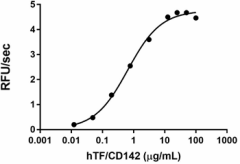
-

Recombinant human TF/CD142 activates the coagulation Factor VII. This activation is measured using the fluorogenic peptide substrate Boc-VPR-AMC. The AC50 for this effect is <4 µg/mL. -

Stability Testing for Recombinant Human TF/CD142. Recombinant Human TF/CD142 was aliquoted in PBS, pH7 at 0.2 mg/mL. One aliquot was frozen and thawed four times (4x Freeze/Thaw) and compared to the control that was kept at 4°C (Control). The samples were tested for their ability to activate the coagulation Factor VII. This activation was measured using the fluorogenic peptide substrate Boc-VPR-AMC. The AC50 for this effect is <4 µg/mL.
Tissue factor (TF), a plasma membrane anchored glycoprotein, is the primary initiator of the coagulation in both physiological and pathological conditions. TF functions as the allosteric cofactor for plasma clotting protease factor VIIa (FVIIa), and the TF-FVIIa complex initiates the coagulation cascade by activating clotting proteins factors IX and X through limited proteolysis. A soluble form of TS has been reported as the result of alternative splicing; this soluble form contains most of the extracellular domain, but lacks the transmembrane domain. Functional TF has been also detected in micro particles (MPs), membrane vesicles of submicron size that result after cell stimulation or apoptosis. TF is also expressed by neutrophils, activated lymphocytes in vitro and in vivo, and by platelets, leukocytes, and platelet-leukocyte aggregates in acute coronary syndromes. In addition to the function of initiator of coagulation, some other functions have been described for TF such as regulation of apoptosis, protein expression, angiogenesis, cell proliferation, and tumor metastasis. High intravascular TF levels have been described in pro-thrombotic syndromes including myocardial infarction, sepsis, sickle-cell disease, and anti-phospholipid syndrome.
Product DetailsProduct Details
- Source
- Human Tissue Factor/CD142, amino acid Gly34-Glu251 (Accession # P13726) was expressed in CHO cells. The C-terminal contains 6His tag.
- Molecular Mass
- The 227 amino acid recombinant protein has a predicted molecular mass of approximately 25.7 kD. The DTT-reduced and non-reduced protein migrate at approximately 35 -45 kD and 30 -40 kD respectively by SDS-PAGE. The predicted N-terminal amino acid is Gly.
- Purity
- >98%, as determined by Coomassie stained SDS-PAGE.
- Formulation
- 0.22 μm filtered protein solution is in PBS pH 7.2.
- Concentration
- 10 and 25 µg sizes are bottled at 200 µg/mL. 100 µg size and larger sizes are lot-specific and bottled at the concentration indicated on the vial. To obtain lot-specific concentration and expiration, please enter the lot number in our Certificate of Analysis online tool.
- Storage & Handling
- Unopened vial can be stored at -70°C for six months. For maximum results, quick spin vial prior to opening. Avoid repeated freeze/thaw cycles.
- Activity
- Recombinant human TF/CD142 activates coagulation Factor VII. This activation is measured using the fluorogenic peptide substrate Boc-VPR-AMC. The AC50 for this effect is <4 µg/mL.
- Application
-
Bioassay
- Application Notes
-
BioLegend carrier-free recombinant proteins provided in liquid format are shipped on blue ice. Our comparison testing data indicates that when handled and stored as recommended, the liquid format has equal or better stability and shelf-life compared to commercially available lyophilized proteins after reconstitution. Our liquid proteins are verified in-house to maintain activity after shipping on blue ice and are backed by our 100% satisfaction guarantee. If you have any concerns, contact us at tech@biolegend.com.
Antigen Details
- Structure
- Monomer
- Distribution
-
Placenta, gall bladder, adventitia of blood vessels, atherosclerotic plaques, monocytes, neutrophils, activated T cells.
- Function
- Initiation of coagulation protease cascade, forming a complex with circulating factor VII or VIIa, finally resulting in thrombin formation.
- Interaction
- Smooth muscle cells, TF-αVβ3 integrin interaction induces endothelial cell migration.
- Ligand/Receptor
- TF is the high affinity receptor for Coagulation factor VII.
- Cell Type
- Endothelial cells, Macrophages, Monocytes, Platelets
- Biology Area
- Cardiovascular Biology
- Molecular Family
- Enzymes and Regulators, Proteases
- Antigen References
-
- Bogdanov VY, et al. 2003. Nat. Medicine. 9:458-62.
- Cirillo P, et al. 2004. Circulation. 109:2911-6.
- Lechner D, Weltermann A. 2008. Thromb. Res. 70019-7.
- Brambilla M, et al. 2008. Arterioscler. Thromb. Vasc. Biol. 107.161471.
- van den Berg YW, et al. 2009. Proc. Natl. Acad. Sci. U S A 0905325106.
- Maugeri N, Manfredi AA. 2015. Semin. Thromb. Hemost. s-0035-1564043.
- De Palma R, et al. 2016. Int. J. Cardiol. 218:188-95.
- Cimmino G, Cirillo P. 2018. Cardiovasc. Diagn. Ther. cdt.2018.10.14.
- Gene ID
- 2152 View all products for this Gene ID
- UniProt
- View information about Tissue Factor/CD142 on UniProt.org
Related Pages & Pathways
Pages
Related FAQs
- Why choose BioLegend recombinant proteins?
-
• Each lot of product is quality-tested for bioactivity as indicated on the data sheet.
• Greater than 95% Purity or higher, tested on every lot of product.
• 100% Satisfaction Guarantee for quality performance, stability, and consistency.
• Ready-to-use liquid format saves time and reduces challenges associated with reconstitution.
• Bulk and customization available. Contact us.
• Learn more about our Recombinant Proteins. - How does the activity of your recombinant proteins compare to competitors?
-
We quality control each and every lot of recombinant protein. Not only do we check its bioactivity, but we also compare it against other commercially available recombinant proteins. We make sure each recombinant protein’s activity is at least as good as or better than the competition’s. In order to provide you with the best possible product, we ensure that our testing process is rigorous and thorough. If you’re curious and eager to make the switch to BioLegend recombinants, contact your sales representative today!
- What is the specific activity or ED50 of my recombinant protein?
-
The specific activity range of the protein is indicated on the product datasheets. Because the exact activity values on a per unit basis can largely fluctuate depending on a number of factors, including the nature of the assay, cell density, age of cells/passage number, culture media used, and end user technique, the specific activity is best defined as a range and we guarantee the specific activity of all our lots will be within the range indicated on the datasheet. Please note this only applies to recombinants labeled for use in bioassays. ELISA standard recombinant proteins are not recommended for bioassay usage as they are not tested for these applications.
- Have your recombinants been tested for stability?
-
Our testing shows that the recombinant proteins are able to withstand room temperature for a week without losing activity. In addition the recombinant proteins were also found to withstand four cycles of freeze and thaw without losing activity.
- Does specific activity of a recombinant protein vary between lots?
-
Specific activity will vary for each lot and for the type of experiment that is done to validate it, but all passed lots will have activity within the established ED50 range for the product and we guarantee that our products will have lot-to-lot consistency. Please conduct an experiment-specific validation to find the optimal ED50 for your system.
- How do you convert activity as an ED50 in ng/ml to a specific activity in Units/mg?
-
Use formula Specific activity (Units/mg) = 10^6/ ED50 (ng/mL)
 Login / Register
Login / Register 





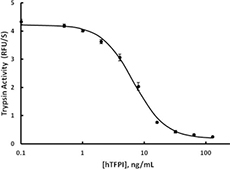
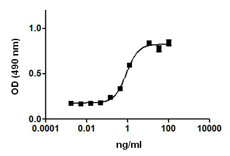
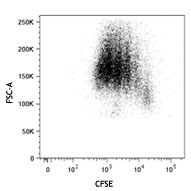
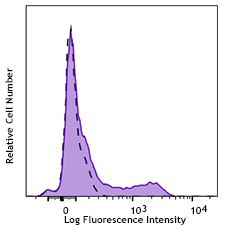



Follow Us